|
Frontal Lobes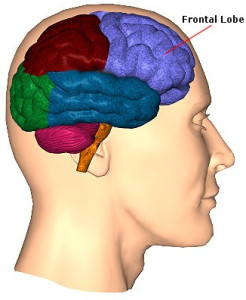
The frontal lobes are part of the Cerebral Cortex and are the largest of the brain’s structures. They are the main site of so–called ‘higher’ Cognitive functions. The frontal lobes contain a number of important substructures, including the prefrontal cortex, orbitofrontal cortex, motor and premotor cortices, and Broca’s area. These substructures are involved in attention and thought, voluntary movement, decision–making, and language.
Associated functions
Executive processes (voluntary behavior such as decision making, planning, problem–solving, and thinking), voluntary motor control, cognition, intelligence, attention, language processing and comprehension, and many others.
The frontals lobes are the brain’s largest structures and consequently have been associated with a large number of disorders. These include ADHD, schizophrenia, and bipolar disorder (prefrontal cortex).
Symptoms of brain tumours affecting the Frontal Lobe
The frontal lobes determine personality and contain the area called the motor cortex that controls movement of the muscles of the body (the motor cortex on the right half of the brain controls the left side of the body and vice versa). The frontal lobes are thought to be the area of the brain most involved in conscious thinking. Symptoms of tumours affecting the frontal lobe can include:
- Personality change
- Loss of inhibition leading to offensive behaviour which is out of character for that person e.g. swearing, rudeness, inappropriate sexual behaviour
- Irritability
- Aggression
- Apathy – loss of interest in life
- Difficulty planning or organising
- Weakness of one side of the face or body
- Problems walking
- Difficulty speaking
|
|
Parietal Lobe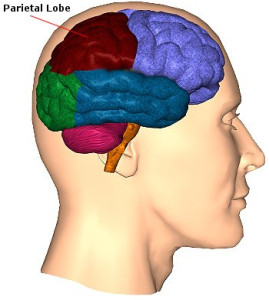
The parietal cortex plays an important role in integrating information from different senses to build a coherent picture of the world. It integrates information from the Ventral visual pathways (which process what things are) and Dorsal visual pathways (which process where things are). This allows us to coordinate our movements in response to the objects in our environment. It contains a number of distinct reference maps of the body, near space, and distant space, which are constantly updated as we move and interact with the world.
The parietal cortex processes attentional awareness of the environment, is involved in manipulating objects, and representing numbers.
Associated functions
- perception and integration of sensory information (e.g. touch, pressure, temperature, and pain)
- visuospatial processing
- spatial attention
- spatial mapping
- number representation
- Associated cognitive disorders
Symptoms of brain tumours affecting the parietal lobe
The parietal lobe contains areas responsible for the sensation of touch and association, this area enables fine judgement of sensation such as texture, weight, size. Symptoms of tumours in this area include:
- Loss of sensation in part of the body
- Sensory or motor neglect – e.g. a person with right sided sensory neglect will not respond to a sound, gesture or touch from or on the right but will respond normally to these stimuli on the left side.
- Difficulty speaking or understanding speech
- Problems with reading and/or writing
|
|
Occipital Lobe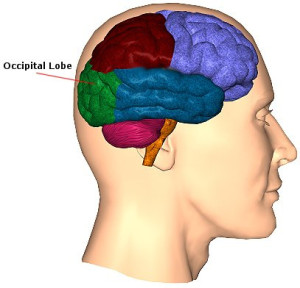
The occipital cortex is the primary visual area of the brain. It receives projections from the retina (via the thalamus) from where different groups of neurons separately encode different visual information such as color, orientation, and motion. Pathways from the occipital lobes reach the temporal and Parietal Lobes and are eventually processed consciously. Two important pathways of information originating in the occipital lobes are the dorsal and ventral streams. The dorsal stream projects to the parietal lobes and processes where objects are located. The ventral stream projects to structures in the temporal lobes and processes what objects are.
Associated functions
Symptoms of brain tumours affecting the occipital lobe
This area is responsible for vision; symptoms include problems with or loss of vision on one side. Blindness that is caused by damage to the visual area of the brain is called ‘central’ or ‘cortical’ blindness.
|
|
Temporal Lobe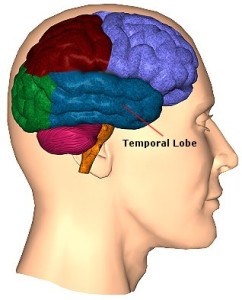
The temporal lobes contain a large number of substructures, whose functions include perception, face recognition, object recognition, memory acquisition, understanding language, and emotional reactions. Damage to the temporal lobes can result in intriguing neurological deficits called agnosias, which refer to the inability to recognize specific categories (body parts, colors, faces, music, smells).
Associated functions
- Recognition
- Perception (hearing, vision, smell)
- Understanding language
- Learning and memory
- Associated cognitive disorders
- Schizophrenia is the cognitive disorder most closely aligned to temporal lobe dysfunction.
Symptoms of brain tumours affecting the temporal lobe
The temporal lobe has many functions including processing of audio and visual information, comprehension and memory of verbal information. Symptoms of tumours in this area include:
- Fits – may be called ‘temporal lobe Epilepsy’; this type of epilepsy is often associated with weird feelings, smells or deja vu sensations which accompany or precede a fit.
- Short term memory problems
- Inability to recall words
|
|
Cerebellum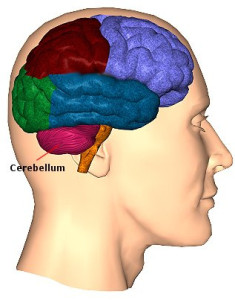
The cerebellum monitors and regulates motor behavior, particularly automatic movements. Some recent studies have associated the cerebellum with cognitive functions, such as learning and attention. Although the cerebellum accounts for roughly 10% of total brain weight, it contains more neurons than the rest of the brain combined. The cerebellum is also one of the few mammalian brain structures where adult neurogenesis (the development of new neurons) has been confirmed.
Associated functions
- coordination of voluntary movement
- motor–learning
- balance
- reflex memory
- posture
- timing
- sequence learning
Symptoms of brain tumours affecting the cerebellum
The cerebellum helps to coordinate balance, symptoms of tumours affecting the cerebellum include:
- Problems with balance and coordination
- Problems with co-ordination of limbs
- Intention tremor
- Abnormal eye movements – ‘nystagmus’
- Nausea and dizziness
|
|
Brain Stem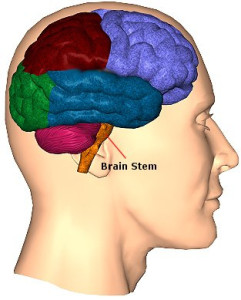
The brain stem consists of a group of structures that lie Deep within the brain, including the Pons, medulla oblongata, and midbrain. It plays an important role in maintaining homeostasis by controlling autonomic functions such as breathing, heart rate, and blood pressure. While the brain stem can organize motor movements such as reflexes, it coordinates with the motor cortex and associated areas to contribute to fine movements of limbs and the face.
Associated functions
- controlling autonomic functions (including blood pressure, breathing, digestion, heart rate, perspiration and temperature)
- alertness
- sleep
- balance
- startle response
- Associated cognitive disorders
Very few cognitive disorders have been associated with the brain stem.
Symptoms of brain tumours affecting the brain stem
Problems in the brainstem often cause things like:
- double vision
- nausea
- sleepiness
- weakness on one side of the body.
However, because so many nerves go through the brainstem, problems here can cause a wide range of symptoms.
(With thanks to BTBuddies.co.uk, Brain Tumour community) |